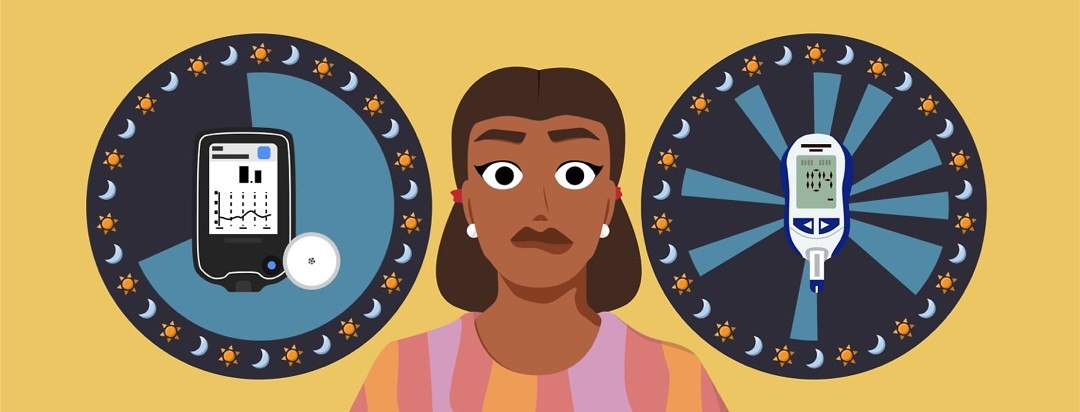How is a Continuous Glucose Monitor Different than My Glucose Meter?
It’s incredible that in a lifetime, we’ve moved from using urine to determine someone’s glucose level, all the way to using devices that continuously monitor glucose levels throughout the day and night.
What is a continuous glucose monitor?
Continuous glucose monitors (CGMS) are quickly gaining hold in the world of type 2 diabetes. So, let’s break down exactly what a CGM is and how it’s different than a blood glucose meter.
A CGM is made of three important components: sensor, transmitter, and receiver. A sensor is a tiny wire which sits in your interstitial fluid (I’ll explain more on that later). The sensor’s job is exactly what it sounds like, to “sense” your glucose level. Once the sensor gauges your glucose level, it needs the help of the transmitter to send your glucose information to a receiver. Note: in some systems, the sensor and transmitter are combined into one piece. Your glucose levels are shown on the receiver. Receivers can be an insulin pump, a handheld device, or an Apple watch. However, the most commonly used receiver is a smartphone.
How does a CGM differ from a glucose meter?
Working together, these three components deliver information about where your glucose levels are at, and, the best part, where they’re headed. This leads us to how CGMs are different than blood glucose meters (BGMs). Here are three major ways:
- CGMs measure the glucose level in the interstitial fluid. This is the fluid that sits in-between the cells of your body. A BGM, however, measures the glucose level in your blood. So, you wouldn’t expect the numbers on a CGM and BGM to match up exactly, because they are measuring the glucose levels in two different areas of your body.
- CGMs give you an ongoing idea of where your glucose level is and where it’s headed. In most cases, CGMS can predict a low blood sugar 20-30 minutes before it happens. BGMs are only a snapshot of time, indicating only what your glucose level is at the time of your check. Think of CGMs as an entire movie, whereas BGMs are only a movie scene. Most CGMs allow you to set personalized alarms for higher or lower glucose levels.
- A CGM is something you wear on your body for a long period of time (usually anywhere from 7-14 days). The fact that you don’t remove it can be a constant reminder of diabetes (which can be either a positive or negative thing, depending on your preference). A BGM, however, is something that can be used and stored out of sight with your other diabetes supplies until next use.
Addtional benefits of a CGM
CGMs are often very easy to use. With the exception of one type of implantable CGM, all can be put on by yourself at home. No need for doctor visits or super invasive procedures. And, for most, putting on a CGM doesn’t even hurt! A CGM can give you more support and information in your diabetes decision making while reducing your burden of diabetes self-care (repeated blood sugar checks).
Who should use either device?
Considering this, a CGM is often the best fit if you’re on medications that require a lot of decision making (like insulin), you struggle with low blood sugar episodes, and/or you monitor your blood sugar many times a day. Beyond this, often the cost and reduction of diabetes self-care burden may not outweigh the benefit of a CGM. However, each decision is personal.
Do your research on different monitors
One final note, do your research on CGMs before you decide which one is right for you. Each system is different. Some have alarms, whereas others do not. Some require you to scan the transmitter to get your readings, whereas others continuously send glucose levels to your receiver. Most don’t require you to check blood sugars, but one system still recommends checks up to 3-4 times a day for the system to work well. Here are a couple of great resources to do your research: diabeteswise.org and Diabetes Forecast’s Annual Consumer’s Guide.
Remember, any diabetes decision is a personal one, and what may work best for one person, may not work well for you. Weigh the pros and cons of a CGM. If you determine it may be the right fit for you, research the different options and talk to your healthcare team about getting one ordered. Also, just an FYI, if insurance covers the cost of a CGM, it typically covers the cost of a few training sessions (usually with a certified diabetes educator) to get it up and running for you. That support and guidance on how to make decisions about your CGM can be invaluable.
What devices have you used since your diagnosis and how have you felt about them?

Join the conversation